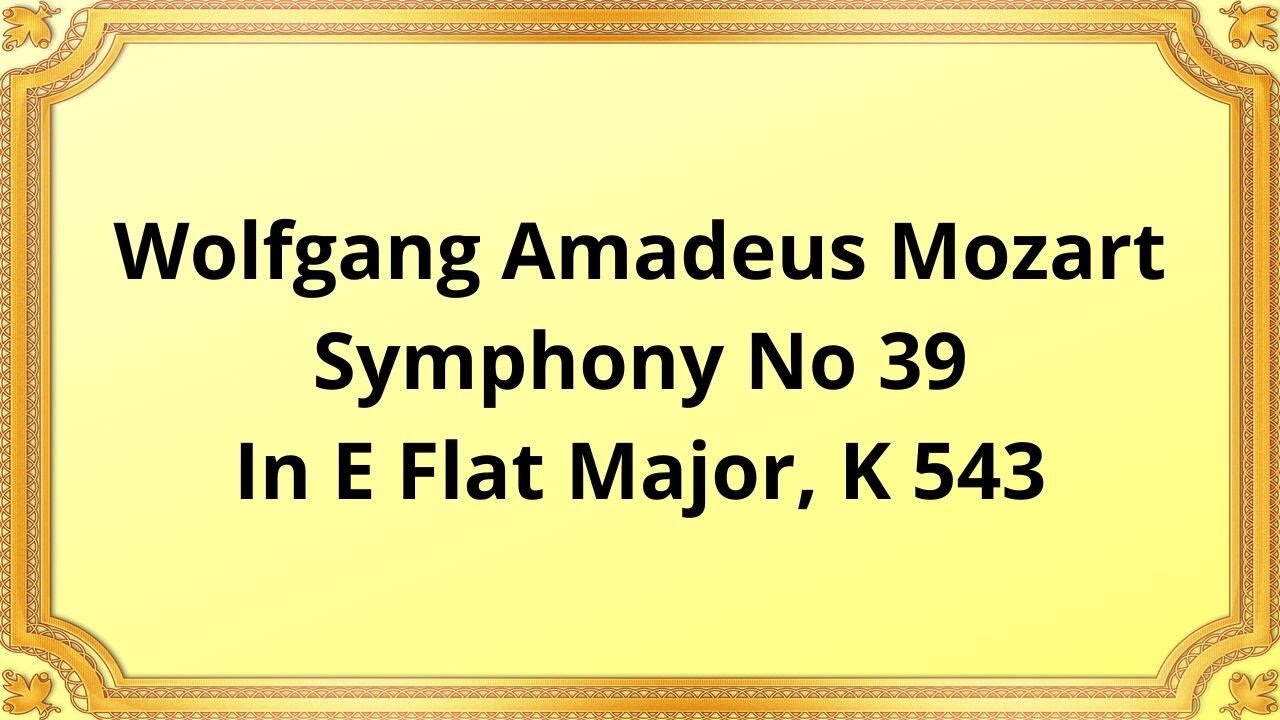Premium Only Content

Wolfgang Amadeus Mozart Symphony No 39 In E Flat Major, K 543
#Mozart#Chamber_music#Classical_music#Symphony#musical_composition
Publication date 1952
The London Symphony Orchestra; Josef Krips
Wolfgang Amadeus Mozart's Symphony No. 39 in E flat major, K. 543 is one of the most popular and beloved symphonies in classical music. Composed in 1788, it was one of Mozart's final three symphonies, all of which he composed within a six-week period. This particular symphony is renowned for its graceful melodies, inventive harmonies, and masterful orchestration, and it continues to be a favorite among both musicians and audiences alike.
Symphony No. 39 is a four-movement work that follows the standard symphonic form of the time. The first movement is in sonata form, with a majestic and imposing opening that sets the tone for the rest of the symphony. The second movement is a slow and expressive adagio, followed by a minuet and trio in the third movement that showcase Mozart's signature elegance and grace. The final movement is a lively and spirited allegro that brings the symphony to a rousing and satisfying conclusion.
One of the most striking characteristics of Symphony No. 39 is its use of orchestration. Mozart was a master of orchestration, and in this symphony, he uses the full range of the orchestra to create a rich and varied sound. The symphony features the standard orchestral instruments of the time, including strings, woodwinds, brass, and percussion, but Mozart also adds clarinets, which were a relatively new addition to the orchestra at the time.
Another hallmark of Symphony No. 39 is its use of melody. Mozart was known for his ability to craft memorable and expressive melodies, and this symphony is no exception. The opening theme of the first movement is majestic and regal, while the second movement features a lyrical and emotional melody that is both beautiful and haunting. The third movement is light and playful, with a charming and memorable melody that is sure to delight listeners.
Symphony No. 39 was composed during a particularly tumultuous time in Mozart's life. He was struggling financially, and his health was beginning to deteriorate. Despite these difficulties, however, Mozart continued to compose at a feverish pace, and the result was one of the greatest periods of creativity in his life. Symphony No. 39, along with his other two final symphonies, marked a turning point in Mozart's career and a culmination of his creative genius.
Conclusion
Wolfgang Amadeus Mozart's Symphony No. 39 in E flat major, K. 543 is a masterpiece of classical music that continues to captivate audiences today. With its graceful melodies, inventive harmonies, and masterful orchestration, it remains one of Mozart's most beloved works
You have the opportunity to support the channel
https://www.donationalerts.com/r/radsiaral
-
 LIVE
LIVE
Price of Reason
8 hours agoThe Establishment WORRIES about Elon Musk AGAIN! Superman Trailer Discussion! Sonic 3 Review!
2,183 watching -
 1:14:54
1:14:54
Steve-O's Wild Ride! Podcast
11 hours ago $4.39 earnedZac Brown Reveals The Secrets To HIs Success - Wild Ride #247
15.7K7 -
 4:16:43
4:16:43
JdaDelete
5 hours ago $2.00 earnedProject Zomboid with the Boys | The Great Boner Jam of 2025
16.6K -
 LIVE
LIVE
SpartakusLIVE
6 hours agoYoung Spartan STUD teams with old gamers for ultimate BANTER with a SMATTERING of TOXICITY
1,041 watching -
 1:50:39
1:50:39
Kim Iversen
7 hours agoShocking Proposal: Elon Musk for Speaker of the House?! | IDF Soldiers Reveal Atrocities—'Everyone Is a Terrorist'
59.5K106 -
 43:27
43:27
barstoolsports
10 hours agoOld Dog Bites Back | Surviving Barstool S4 Ep. 9
96.7K3 -
 5:13:04
5:13:04
Right Side Broadcasting Network
7 days agoLIVE REPLAY: TPUSA's America Fest Conference: Day One - 12/19/24
157K25 -
 1:06:01
1:06:01
Man in America
1 day agoPfizer Has Been Caught RED HANDED w/ Dr. Chris Flowers
43.3K11 -
 2:24:15
2:24:15
Slightly Offensive
8 hours ago $11.78 earnedAttempted ASSASSINATION of Nick J Fuentes LEAVES 1 DEAD! | Guest: Mel K & Breanna Morello
35.7K18 -
 1:43:08
1:43:08
Roseanne Barr
7 hours ago $20.25 earned"Ain't Nobody Good" with Jesse Lee Peterson | The Roseanne Barr Podcast #79
72.9K32